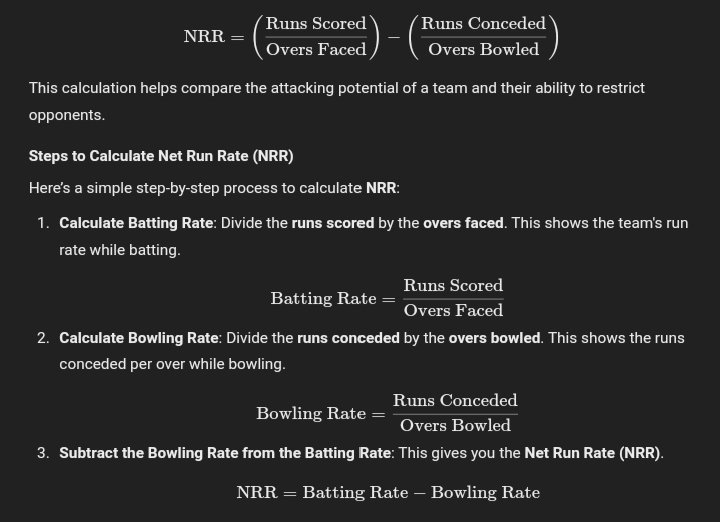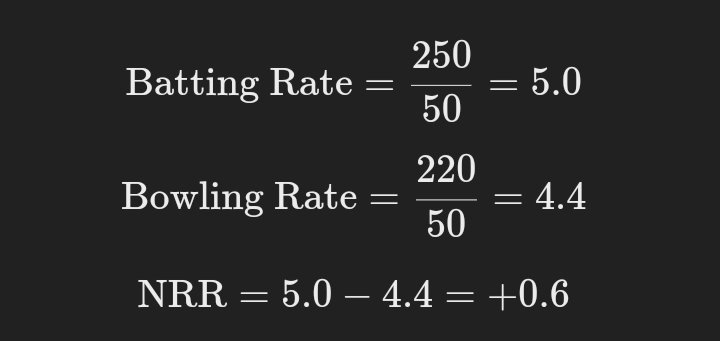Net Run Rate Calculator
Net Run Rate Calculator: Understanding and Using the Essential Cricket Metric
In the world of cricket, the Net Run Rate (NRR) is a crucial metric used to determine a team's standing in a tournament, especially when teams are tied on points. Whether you're a cricket enthusiast, a player, or someone involved in organizing tournaments, understanding how to calculate and use Net Run Rate is essential. This article dives deep into the Net Run Rate Calculator, explaining how to use it and why it matters in competitive cricket.
What is Net Run Rate (NRR)?
The Net Run Rate is a calculation that helps determine a team's performance relative to others when teams have the same points. It takes into account a team's total runs scored, overs faced, runs conceded, and overs bowled, providing a more comprehensive view of their overall performance. NRR is used in leagues and tournaments like the ICC to break ties between teams.
Why is NRR Important in Cricket?
When two or more teams are level on points in a league or tournament, Net Run Rate becomes the deciding factor for qualification or final rankings. The higher the NRR, the better a team’s standing. Essentially, a team's NRR reflects:
- Batting Strength: How well a team scores in comparison to the overs they face.
- Bowling Efficiency: How well a team restricts the opposition's scoring rate while bowling.
How is NRR Calculated?
The formula for Net Run Rate is:

Using a Net Run Rate Calculator
While the formula is straightforward, using a Net Run Rate Calculator simplifies the process, especially when dealing with multiple teams or tournament scenarios. A Net Run Rate Calculator allows players, fans, and organizers to instantly calculate the NRR with the following inputs:
- Runs Scored: Total runs made by the team while batting.
- Overs Faced: Total number of overs faced by the team.
- Runs Conceded: Total runs given by the team while bowling.
- Overs Bowled: Total overs bowled by the team.
With these inputs, the Net Run Rate Calculator quickly computes the result, helping to save time and reduce human error. This tool is particularly useful in tournament scenarios where decisions may hinge on such metrics.
Practical Example of NRR Calculation
Let’s go through a simple example to demonstrate how Net Run Rate works:
Team A scores 250 runs in 50 overs (batting), while they concede 220 runs in 50 overs (bowling).
Using the formula:

Team A’s Net Run Rate (NRR) is +0.6.
How to Use NRR in Tournaments?
In tournaments, NRR becomes particularly crucial in situations where teams are tied on points. Here’s how NRR can influence tournament outcomes:
- Breaking Ties: When two or more teams have the same number of points in a round-robin format, the team with the higher NRR qualifies.
- Ranking: If teams are tied in points, NRR helps to determine their relative positions in the standings.
- Predicting Qualification: Teams that perform well in terms of both scoring and restricting runs typically have a better NRR, making them favorites for qualification.
Conclusion
The Net Run Rate (NRR) is an indispensable part of modern cricket, used to break ties and determine team rankings in tournaments. With a Net Run Rate Calculator, teams, fans, and organizers can easily calculate the NRR, ensuring quick and accurate results. Whether you’re following the ICC tournaments or organizing your own local cricket competition, mastering the use of NRR and having access to a reliable NRR Calculator can make a big difference in the final standings and outcomes.
